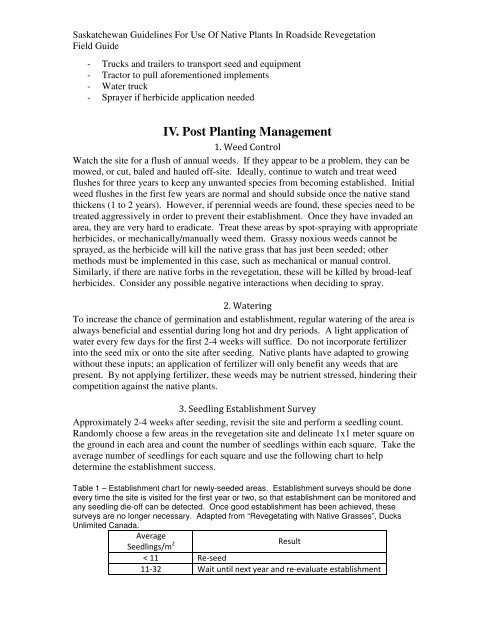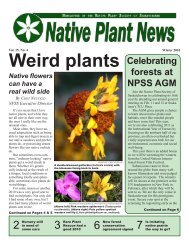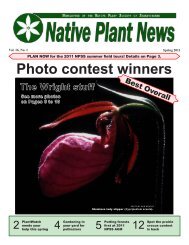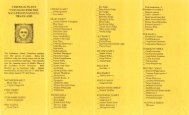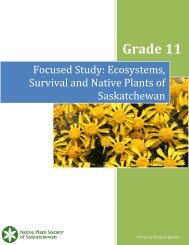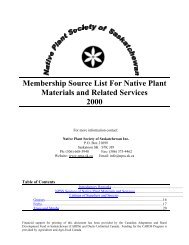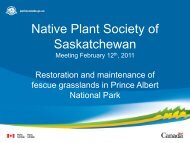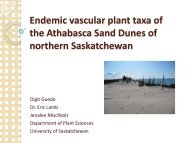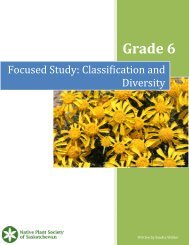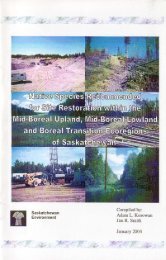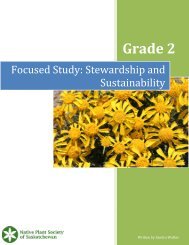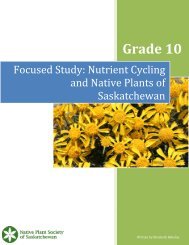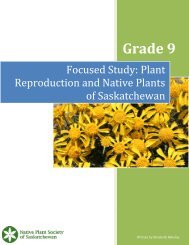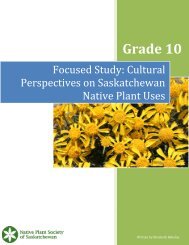Saskatchewan Guidelines For Use Of Native Plants In Roadside ...
Saskatchewan Guidelines For Use Of Native Plants In Roadside ...
Saskatchewan Guidelines For Use Of Native Plants In Roadside ...
You also want an ePaper? Increase the reach of your titles
YUMPU automatically turns print PDFs into web optimized ePapers that Google loves.
<strong>Saskatchewan</strong> <strong>Guidelines</strong> <strong>For</strong> <strong>Use</strong> <strong>Of</strong> <strong>Native</strong> <strong>Plants</strong> <strong>In</strong> <strong>Roadside</strong> Revegetation<br />
Field Guide<br />
- Trucks and trailers to transport seed and equipment<br />
- Tractor to pull aforementioned implements<br />
- Water truck<br />
- Sprayer if herbicide application needed<br />
IV. Post Planting Management<br />
1. Weed Control<br />
Watch the site for a flush of annual weeds. If they appear to be a problem, they can be<br />
mowed, or cut, baled and hauled off-site. Ideally, continue to watch and treat weed<br />
flushes for three years to keep any unwanted species from becoming established. <strong>In</strong>itial<br />
weed flushes in the first few years are normal and should subside once the native stand<br />
thickens (1 to 2 years). However, if perennial weeds are found, these species need to be<br />
treated aggressively in order to prevent their establishment. Once they have invaded an<br />
area, they are very hard to eradicate. Treat these areas by spot-spraying with appropriate<br />
herbicides, or mechanically/manually weed them. Grassy noxious weeds cannot be<br />
sprayed, as the herbicide will kill the native grass that has just been seeded; other<br />
methods must be implemented in this case, such as mechanical or manual control.<br />
Similarly, if there are native forbs in the revegetation, these will be killed by broad-leaf<br />
herbicides. Consider any possible negative interactions when deciding to spray.<br />
2. Watering<br />
To increase the chance of germination and establishment, regular watering of the area is<br />
always beneficial and essential during long hot and dry periods. A light application of<br />
water every few days for the first 2-4 weeks will suffice. Do not incorporate fertilizer<br />
into the seed mix or onto the site after seeding. <strong>Native</strong> plants have adapted to growing<br />
without these inputs; an application of fertilizer will only benefit any weeds that are<br />
present. By not applying fertilizer, these weeds may be nutrient stressed, hindering their<br />
competition against the native plants.<br />
3. Seedling Establishment Survey<br />
Approximately 2-4 weeks after seeding, revisit the site and perform a seedling count.<br />
Randomly choose a few areas in the revegetation site and delineate 1x1 meter square on<br />
the ground in each area and count the number of seedlings within each square. Take the<br />
average number of seedlings for each square and use the following chart to help<br />
determine the establishment success.<br />
Table 1 – Establishment chart for newly-seeded areas. Establishment surveys should be done<br />
every time the site is visited for the first year or two, so that establishment can be monitored and<br />
any seedling die-off can be detected. Once good establishment has been achieved, these<br />
surveys are no longer necessary. Adapted from “Revegetating with <strong>Native</strong> Grasses”, Ducks<br />
Unlimited Canada.<br />
Average<br />
Result<br />
Seedlings/m 2<br />
< 11 Re-seed<br />
11-32 Wait until next year and re-evaluate establishment


